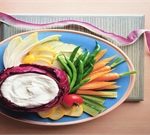(HealthDay News) — Allergic reactions are sensitivities to allergens. From animal dander to foods, allergens may cause hives, itching, a rash and other symptoms. For a mild-to-moderate reaction, MedlinePlus mentions these first aid steps: Calm and reassure the person having the reaction. Try to identify the allergen and have the person avoid additional contact with it. If the person develops a rash, apply cool a compress and hydrocortisone. Watch the person for signs of increasing distress. Get prompt medical help. If the allergic reaction is severe, call 911 immediately.
All Eats:
TV Can Be a Good Influence on Kids’ Eating Habits

Can television teach kids how to eat healthy? Maybe, suggests new research. Watching cooking shows that featured healthy recipes seemed to encourage healthy eating in children, the study showed. “The findings from this study indicate cooking programs can be a promising tool for promoting positive changes in children’s food-related preferences, attitudes and behaviors,” said lead author Frans Folkvord, from Tilburg University in the Netherlands. The researchers recruited 125 children, aged 10 to 12, who watched 10 minutes of a Dutch public television cooking program designed for children. All were offered a snack as a reward for taking part in the study. Some of the children watched an episode featuring healthy food, while others watched an episode featuring unhealthy food. Those who watched the healthy episode were 2.7 times more likely to choose a healthy snack (an apple or a few pieces of cucumber) than an unhealthy snack (a handful of chips or salted mini-pretzels). The study was published Jan. 8 in the Journal of Nutrition Education and Behavior. Previous research has found children are more likely to eat healthy foods such as fruits and vegetables if they help prepare meals. However, the growing reliance on ready-prepared foods and fewer parents preparing fresh foods have led to a drop in cooking skills among children, the researchers said. They noted that the study was conducted at the… read on >
Festive Foods Can Leave Those on Restricted Diets Out in the Cold

Elaborate feasts are a centerpiece of the holidays, but all that food can make people with restricted diets feel left out, a new study suggests. People whose allergies or health, religious or cultural norms keep them from sharing the meals with others can leave them lonely, researchers say. “Despite being physically present with others, having a food restriction leaves people feeling left out because they are not able to take part in bonding over the meal,” said researcher Kaitlin Woolley, an assistant professor of marketing at Cornell University. A review of seven previously published studies found that restricted diets predicted loneliness among both children and adults. In one experiment, for instance, when people without food restrictions were given restrictions, they felt lonely. This suggests that these feelings aren’t the result of other issues or just picky eating, Woolley said. More evidence came from people who attended a Passover Seder. When they were reminded that they couldn’t eat leavened foods, participants felt lonelier. But within their restricted group, they felt a stronger bond. In earlier research, Woolley found that strangers felt more connected and trusting when they shared the same food. Also, sharing food from the same plate increased cooperation between strangers. But restricted sharing makes people suffer “food worries,” she said. They’re concerned about what they can eat and if others will judge them for… read on >
Some Solid Advice on New Year’s Resolutions That Might Stick

If you plan to make a New Year’s resolution about improving your health, the American Medical Association (AMA) has some good suggestions. “With too many holiday sweets and not enough exercise likely in the rearview mirror, now is the perfect time to consider your personal goals and how you can make positive health choices in the coming year,” AMA President Dr. Patrice Harris said in an association news release. “The good news is that there are a few easy steps you can take that will set you on the right track for a healthier 2020,” Harris added. Learn your risk for type 2 diabetes and take steps to prevent or delay the onset of the disease. Get the recommended amount of physical activity. For adults, it’s at least 150 minutes a week of moderate-intensity activity, or 75 minutes a week of vigorous-intensity activity. Know your blood pressure and, if you have high blood pressure, take steps to get it under control. Doing so will reduce your risk of heart attack or stroke. Cut back on processed foods, especially those with added sodium and sugar. Eat less red meat and processed meats, and eat more plant-based foods, such as olive oil, nuts and seed. Reduce your consumption of sugar-sweetened beverages and drink more water instead. If you’re prescribed antibiotics, take them exactly as directed. Antibiotic resistance… read on >
Better Choices for a Fast, Healthy Lunch

Rushed for lunch? Yes, that nearby fast-food chain is convenient, but by tweaking your choices you can cut unwanted salt, fat and calories. When the U.S. Department of Agriculture (USDA) updates its food guidelines, it doesn’t exactly break down how you’re supposed to fit all the healthy parts of the food pyramid into your lunch. To make it easier to make healthy choices, the Choose My Plate initiative crafted a campaign that suggests small changes that take little effort, but ones that will rev up the nutrition quotient for your midday meal. These can be as simple as switching out one item for another. Think vinaigrette instead of creamy salad dressings, and grilled proteins instead of those fried chicken tenders. If two slices of pizza with pepperoni are your favorite go-to option, replace one slice with a side salad and have the other topped with vegetables. You can apply these same principles when you pack a brown-bag lunch. Modifying perennial lunchtime favorites just a speck can make a real difference in nutrients without sacrificing taste. For instance, instead of peanut butter and jelly with a small bag of chips, switch to peanut butter and banana and add baby carrots for some crunch. You’ll cut calories by about 45% and slice saturated fat in half. Love chicken salad? Next time it’s on your menu, cut the… read on >
Toast a Healthy New Year With These Holiday Cocktail Recipes

Looking to ring in the New Year with cocktails that are lower in calories? Here are three delicious options worthy of a special celebration any time of the year with a little fruit tossed in for good measure. For an elegant pink champagne cocktail, to each glass add 4 ounces of dry champagne or Spanish cava and 1 ounce of a raspberry- or rhubarb-flavored liquor like Aperol, a milder and less alcoholic aperitif compared to Campari. Top it off with a few fresh raspberries. For a pear-flavored Cosmopolitan, place 2 pear slices (you can leave on the skin), 1 tablespoon of lime juice and 1 ounce of cranberry juice in a shaker. Add 1-1/2 ounces of a citrus-flavored vodka and 1/2 ounce of triple sec, followed by ice. Shake well, then strain into a martini glass. Garnish with a pinch of cinnamon or ground cardamom. Want a festive recipe for a large gathering? Try a zesty gin fizz made with the luscious citrus of the season, blood oranges. Blood Orange Gin Fizz 3 blood oranges 1-1/2 cups gin 2 tablespoons sweetener of your choice 1/2 teaspoon bitters 2 bottles chilled champagne Cut one orange into 12 segments to use for garnishing and set aside. Remove the peel and pith from the other two oranges. Chop the segments and then mash them in a bowl. Add… read on >
A Breakfast Fit for Making Your New Year’s Resolutions

New Year’s Day is typically when you vow to start a new diet to take off any weight you put on over the holidays or have been carrying. This year, make your resolutions attainable — slight changes that improve health without making impossible-to-meet demands on yourself. If you enjoyed yourself last night, New Year’s Day morning is a time to relax, not stress out in the kitchen. For a great breakfast, consider a baked egg casserole. It can be prepped the day before and finished while everyone enjoys a morning beverage. Whole eggs are an unsung superfood loaded with nutrition. They contain all eight essential amino acids. They’re high in protein plus an important brain nutrient called choline, which is also essential for metabolism. If possible, shop for pasture-raised or organic eggs for their higher omega-3 fatty acid content. New Year’s Egg and Herb Casserole Olive oil cooking spray 6 eggs 2 cups skim milk 1 cup grated Parmesan cheese 1 tablespoon your choice of chopped herbs, such as rosemary or thyme 1 teaspoon baking powder 1/2 teaspoon freshly ground black pepper 2 cups diced lean ham Preheat oven to 350 degrees if cooking the casserole right away. Spray a 7-by-11-inch casserole dish with cooking spray. In a large bowl, whisk eggs, milk, Parmesan, herbs, baking powder and black pepper until well combined. Fold in… read on >
Could You Be Allergic to Additives?

You suddenly break out in a rash or your throat gets scratchy. You assume you’re allergic to something … maybe pollen or a detergent. But could you be allergic to something in your food or medicine, and how could you tell? The medical community disagrees as to whether additives in food or even medications — such as dyes, preservatives or emulsifiers — cause true allergic reactions. And many are convinced that if reactions do occur, they are rare rather than widespread. The traditional thinking has been that the molecules from chemicals in food are too small to cause major reactions. But one small study, published in the Journal of Drugs in Dermatology, found that patients who had skin disorders improved when they switched to medications without the dyes FD&C Blue No. 1 (bright blue) and Blue No. 2 (indigo carmine). The researchers stated that reactions to agents that color medications and foods may be more common than once appreciated. Common Food Additives Vitamins Minerals Flavorings Colorings Preservatives In recent years, the move towards all things “natural” has caused many food manufacturers to switch from synthetic additives to natural ones derived from plant, animal or even insect byproducts. Ironically, some experts say that our bodies may react more to natural than synthetic dyes and preservatives because our immune system is trained to recognize them as invading… read on >
Fatty Diets Tied to Leading Cause of Vision Loss in Seniors

Diets heavy in red meat and fatty foods could help spur a leading cause of vision loss in older Americans, new research suggests. The study found that people who ate more typical Western diets were three times more likely to develop an eye condition that robs you of your central vision — late-stage age-related macular degeneration. “What you eat seems to be important to your vision, and to whether or not you have vision loss later in life,” said study lead author Amy Millen. She’s an associate professor in the department of epidemiology and environmental health at the University at Buffalo’s School of Public Health and Health Professions, in Buffalo, N.Y. “People know that diet influences cardiovascular risk and the risk of obesity, but the public may not know that diet can affect vision loss,” Millen said. Age-related macular degeneration occurs when a part of the eye called the macula is damaged. Sometimes this happens when deposits called drusen grow on the macula. Or it can occur when new blood vessels keep forming and leak blood, scarring the macula, according to the American Academy of Ophthalmology. Genetics and smoking are known risk factors for age-related macular degeneration. The study included almost 1,300 people from a nationally representative sample. Most did not have macular degeneration. There were 117 who had early AMD, and 27 had late.… read on >
Recipes for Healthy Holiday Appetizers

Finger foods are delicious, but they can pack on the calories even when you just nibble. Here are two appetizer makeovers with plenty of flavor and a lot less fat. Jalapeno poppers are a favorite thanks to their creamy filling and crunchy coating. By baking instead of deep frying them, you’ll cut back on hundreds of calories yet keep the crunch. Another crowd pleaser is taco dip. Ingredients with a lower fat content make all the difference in this recipe. Baked Jalapeno Poppers 12 fresh jalapeno peppers, halved lengthwise, stems, seeds and membranes removed 8 ounces reduced-fat cream cheese 1 cup grated part-skim mozzarella 1 teaspoon cumin or fennel seeds, slightly crushed 1 teaspoon mild ground chili powder 1/4 teaspoon freshly ground black pepper 1 egg 2 egg whites 1/2 cup whole wheat flour 1 cup seasoned breadcrumbs 1/2 teaspoon salt Note: Wear disposable gloves to prepare the jalapenos to minimize the capsaicin that gets on your fingers. Preheat oven to 350 degrees. Lightly coat a large baking sheet with nonstick spray and set aside. In a large bowl, mash together cream cheese, mozzarella, cumin or fennel seeds, chili powder and black pepper. In a shallow dish, whisk the egg and egg whites. Spread out the flour on a sheet of wax paper. Spread breadcrumbs on another sheet of wax paper. Fill each pepper half… read on >




















-300x200.jpg)







-300x169.jpg)
